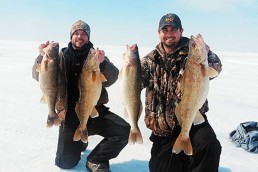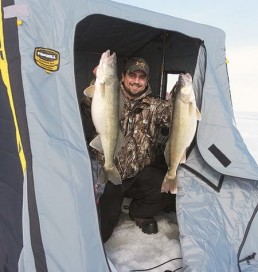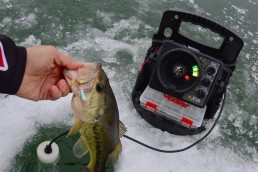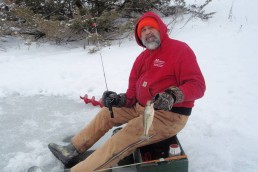Size Matters when it comes to Ice Fishing
SHARE THIS POST
Size matters: The “next best thing” for ice fishing may be as simple as bringing a different size lure with you on your next fishing trip.
As an ice fisherman, it’s always a great feeling waking up on the first day of ice fishing season. The days prior are full of excitement and anticipation. For some, this might even include a last minute scramble the night before printing out licenses and packing up everything but the kitchen sink.
One of those items usually included is a tackle box. Large or small, they are typically jam-packed full of tackle. Some lures may be bargain-bin discounts, some proven killers or some may have been recently added claiming to be the “next best thing.” We often focus much attention to colors, shapes and textures. How often do we pay attention size? How often do we buy the same lure of one color in multiple sizes?
Being an avid fisherman myself, I’ve focused a lot my attention on being prepared with a wide variety of bait and tackle. My thinking behind this was simple: “More variety of lures equals more chances to catch a fish.”
This was a good idea, right? In most cases this theory makes logical sense. However, on my last ice fishing trip, I was proven wrong.
Back on March 8 this year, five other guys and I took our chances to pursue some late-season ice walleyes out on Lake Erie. Fortunately, that morning we found the fish in the first holes we drilled. The walleyes were—with no surprise—biting on blue/chrome-colored lures. Acme Cleos (1/3 ounce) and Jigging Raps No. 07, both tipped with three minnows were the ticket. Most of us were doing very well until 9 a.m., when all of a sudden the bite got as cold as the ice we were sitting on. The fish decided to “turn off” in a matter of minutes. At that point, typically we would’ve moved to a different location. But with still seeing lots of fish on our flashers, we decided to stay.
Several of us decided to change lures and colors. Larger Rapalas, Cleos, Buckshots and Do-Jiggers were all being tested out with no luck. However, one person in our group seemed to be immune to this 9 a.m. freeze. He kept pulling in fish.
Are you enjoying this post?
You can be among the first to get the latest info on where to go, what to use and how to use it!
What was he using?
I stuck my head through the door of his shanty and he was using a Blue/Chrome Jigging Rap, just like before.
Puzzled, I asked how he was still catching fish?
He simply replied, “I just switched sizes.”
He had switched from his larger No. 09 Jigging Rap to a size No. 03. After being a little shocked that walleyes were biting on such a small presentation, I decided to try it out myself. Using the same colors as before, I tied on a 1/8-ounce version of the blue/chrome Acme Cleo, tipped with only one minnow this time. I then dropped my line down the hole and wham.
Before I knew it, I was reeling in my personal best walleye at 9 pounds, 3 ounces and 29 inches long. We all then switched back to smaller versions of what we had been using earlier that morning. The six of us landed over 32 walleyes by 11:45 a.m. Most of the bigger ones were released, and it was for sure a morning to remember.
After that day, we reflected on our previous trips to Erie. We noticed that fish don’t necessarily want the same bait throughout the season. Larger presentations worked better in the mornings, and smaller presentations worked better midday and evenings. I truly believe it’s good to have a variety of tackle, but just as importantly, also having different size variations. If you can find out what the fish are biting on early, sometimes it only takes change in size to keep the action going the rest of the day.
MWO
SHARE THIS POST
Did you enjoy this post?
You can be among the first to get the latest info on where to go, what to use and how to use it!
Matt Patka
MidWest Outdoors works with more than 200 outdoor experts each year, who contribute articles based on their areas of expertise. MidWest Outdoors magazine offers more fishing and hunting articles than any other publication!




